by Eric Meier
When attempting to identify a wood sample, it’s important to keep in mind the limitations and obstacles that are present in our task. Before starting, please have a look at The Truth Behind Wood Identification to approach the task in a proper mindset; I consider the linked article to be required reading for all those visiting my site with the intent of identifying wood.
1. Confirm it is actually solid wood.
Before proceeding too much farther into the remaining steps, it’s first necessary to confirm that the material in question is actually a solid piece of wood, and not a man-made composite or piece of plastic made to imitate wood.
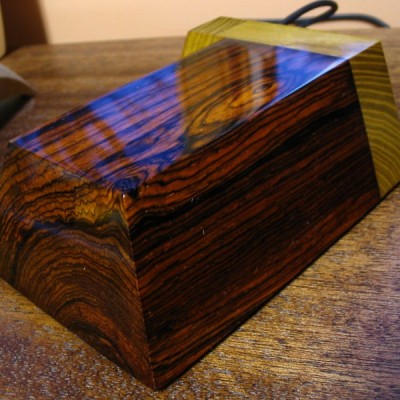
Can you see the end-grain?
Manufactured wood such as MDF, OSB, and particleboard all have a distinct look that is—in nearly all cases—easily distinguishable from the endgrain of real wood. Look for growth rings—formed by the yearly growth of a tree—which will be a dead-giveaway that the wood sample in question is a solid, genuine chunk of wood taken from a tree.
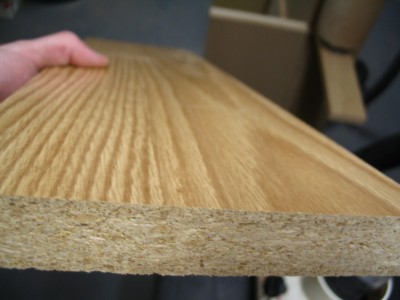
Is it veneered?
If you see a large panel that has a repeating grain pattern, it may be a veneer. In such cases, a very thin layer of real wood is peeled from a tree and attached to a substrate; sometimes the veneer can be one continuous repeating piece because it is rotary-sliced to shave off the veneer layer as the tree trunk is spun by machines. Assuming it is a real wood veneer with a distinct grain and texture—and not merely a piece of printed plastic—you may still be able to identify the outer veneer wood in question, but you should still realize that is it only a veneer and not a solid piece of wood.
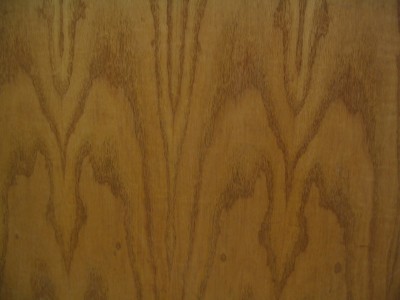
Is it painted or printed to look like wood?
Many times, especially on medium to large-sized flat panels for furniture, a piece of particleboard or MDF is either laminated with a piece of wood-colored plastic, or simply painted to look like wood grain. Many of today’s interior hardwood flooring planks are good examples of these pseudo-wood products: they are essentially a man-made material made of sawdust, glues, resins, and durable plastics.
2. Look at the color.
Some questions to immediately ask yourself:
Is the color of the wood natural, or is it stained?
If there is even a chance that the color isn’t natural, the odds are increased that the entire effort of identifying the wood will be in vain.
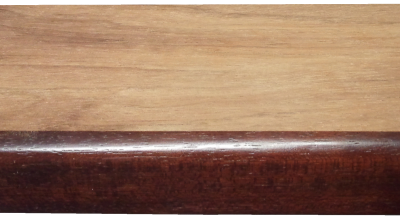
Is it weathered or have a patina?
Many woods, when left outside in the elements, tend to turn a bland gray color. Also, even interior wood also takes on a patina as it ages: some woods get darker, or redder, and some even get lighter or lose their color; but for the most part, wood tends to darken with age.
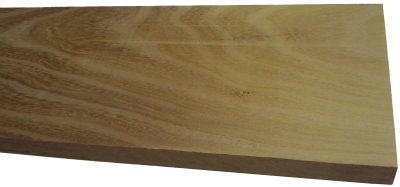
Is it possible to sand or plane the board to see the natural raw color of the wood?
The most predictable baseline to use when identifying wood is in a freshly sanded state. This eliminates the chances of a stain or natural aging skewing the color diagnosis of the wood.
3. Observe the wood grain.
If the wood is unfinished, then look at the texture of the grain. Ask yourself these questions:
Does the wood have an open, porous texture?
Most softwoods will be almost perfectly smooth with no grain indentations, while many common hardwoods have an open pore structure, such as oak or mahogany; though there are some hardwoods that are also smooth to the touch, such as maple.
Can you tell if the wood is quartersawn or plainsawn?
By observing the grain patterns, many times you can tell how the board was cut from the tree. Some wood species have dramatically different grain patterns from plainsawn to quartersawn surfaces. For instance, on their quartersawn surfaces, lacewood has large lace patterns, oak has flecks, and maple has the characteristic “butcher block” appearance.
Is there any figure or unusual characteristics, such as sapwood, curly or wild grain, burl/knots, etc.?
Some species of wood have figure that is much more common than in other species: for example, curly figure is fairly common in soft maple, and the curls are usually well-pronounced and close together. Yet when birch or cherry has a curly grain, it is more often much less pronounced, and the curls are spaced farther apart.
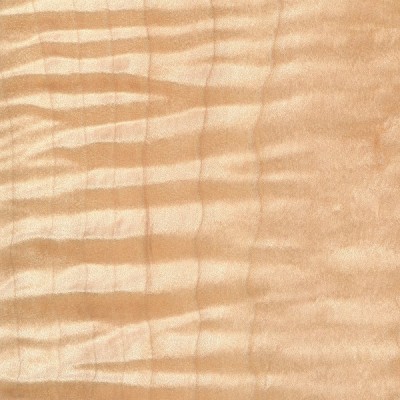
4. Consider the weight and hardness of the wood.
If it’s possible, pick the piece of wood up and get a sense of its weight, and compare it to other known wood species. Try gouging the edge with your fingernail to get a sense of its hardness. If you have a scale, you can take measurements of the length, width, and thickness of the wood, and combine them to find the density of the wood. This can be helpful to compare to other density readings found in the database. When examining the wood in question, compare it to other known wood species, and ask yourself these questions:
Is the wood dry?
Wood from freshly felled trees, or wood that has been stored in an extremely humid environment will have very high moisture contents. In some freshly sawn pieces, moisture could account for over half of the wood’s total weight! Likewise, wood that has been stored in extremely dry conditions of less than 25% relative humidity will most likely feel lighter than average.
How does the wood’s weight compare to other species?
Taking into account the size of the board, how does its weight compare to other benchmark woods? Is it heavier than oak? Is it lighter than pine? Look at the weight numbers for a few wood species that are close to yours, and get a ballpark estimate of its weight.
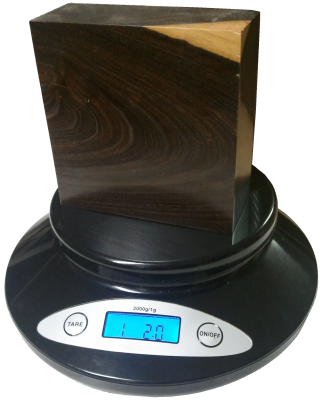
How hard is the wood?
Obviously softwoods will tend to be softer than hardwoods, but try to get a sense of how it compares to other known woods. Density and hardness are closely related, so if the wood is heavy, it will most likely be hard too. If the wood is a part of a finished item that you can’t adequately weigh, you might be able to test the hardness by gouging it in an inconspicuous area. Also, if it is used in a piece of furniture, such as a tabletop, a general idea of its hardness can be assessed by the number and depth of the gouges/dings in the piece given its age and use. A tabletop made of pine will have much deeper dents than a tabletop made of Oak. Additionally, you can always try the “fingernail test” as a rough hardness indicator: find a crisp edge of the wood, and with your fingernail try to push in as hard as you can and see if you’re able to make a dent in the wood.
5. Consider its history.
Many times we forget common sense and logic when attempting to identify wood. If you’ve got a piece of Amish furniture from Pennsylvania, chances are more likely that the wood will be made of something like black walnut or cherry, and not African wenge or jatoba. You might call it “wood profiling,” but sometimes it can pay to be a little prejudiced when it comes to wood identification. Some common-sense questions to ask yourself when trying to identify a piece of wood:
Where did it come from?
Knowing as much as you can about the source of the wood—even the smallest details—can be helpful. If the wood came from a wood pile or a lumber mill where all the pieces were from trees processed locally, then the potential species are immediately limited. If the wood came from a builder of antique furniture, or a boat-builder, or a trim carpenter: each of these occupations will tend to use certain species of woods much more often than others, making a logical guess much simpler.
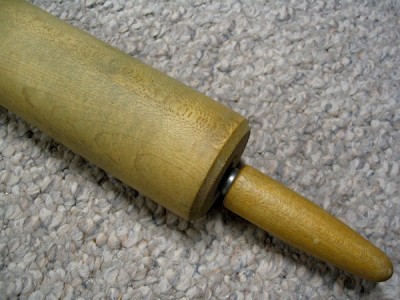
How old is it?
As with the wood’s source, its age will also help in identification purposes. Not only will it help to determine if the wood should have developed a natural patina, but it will also suggest certain species which were more prevalent at different times in history. For instance, many acoustic guitars made before the 1990s have featured Brazilian rosewood backs/sides, yet due to CITES restrictions placed upon that species, East Indian rosewood became a much more common species on newer guitars. (And this is a continuing shift as newer replacements are sought for rosewoods altogether.)
How large is the piece of wood?
Some species of trees are typically very small—some are even considered shrubs—while others get quite large. For instance, if you see a large panel or section of wood that’s entirely black, chances are it’s either painted, dyed, or stained: Gaboon ebony and related species are typically very small and very expensive.
What is the wood’s intended use?
Simply knowing what the wood was intended for—when considered in conjunction with where it came from and how old it is—can give you many clues to help identify it. In some applications, certain wood species are used much more frequently than others, so that you can make an educated guess as to the species of the wood based upon the application where it was used. For instance, in the United States: many older houses with solid hardwood floors have commonly used either red oak or hard maple; many antique furniture pieces have featured quartersawn white oak; many violins have spruce tops; many closet items used aromatic red cedar, and so forth. While it’s not a 100% guarantee, “profiling” the wood in question will help reduce the number of possible suspects, and aid in deducing the correct species.
6. Find the X-Factor.
Sometimes, after all the normal characteristics of a sample have been considered, the identity of the wood in question is still not apparent. In these instances—particularly in situations where a sample has been narrowed down to only a few possible remaining choices—it’s sometimes helpful to bring in specialized tests and other narrower means of identification.
The following techniques and recommendations don’t necessarily have a wide application in initially sorting out wood species and eliminating large swaths of wood species, but will most likely be of use only as a final step in special identification circumstances.
Odor
Believe it or not, freshly machined wood can have a very identifiable scent. When your eyes and hands can’t quite get a definitive answer, sometimes your nose can. Assuming there is no stain, finish, or preservative on or in the wood, quickly sand, saw, or otherwise machine a section of the wood in question, and take a whiff of the aroma.
Although new scents can be very difficult to express in words, many times the scent of an unknown wood may be similar to other known scents. For instance, rosewoods (Dalbergia spp.) are so named for their characteristic odor that is reminiscent of roses. Although difficult to directly communicate, with enough firsthand experience scents can become a memorable and powerful means of wood identification.
Fluorescence
While certain woods can appear basically identical to one another under normal lighting conditions, when exposed to certain wavelengths—such as those found in blacklights—the wood will absorb and emit light in a different (visible) wavelength. This phenomenon is known as fluorescence, and certain woods can be distinguished by the presence or absence of their fluorescent qualities. See the article Fluorescence: A Secret Weapon in Wood Identification for more information.
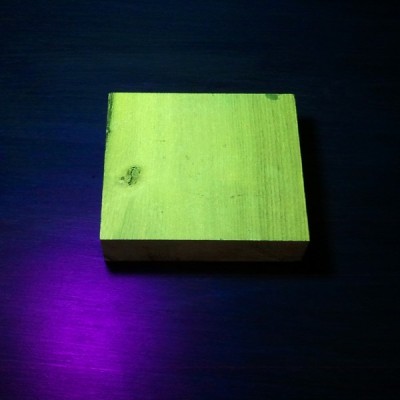
Chemical Testing
There are only a small number of chemical tests regularly used on wood, most of which are very specialized and were developed to help distinguish easily confused species with one another. They work by detecting differences in the composition of heartwood extractives. A chemical substance (called a reagent) is usually dissolved in water and applied to the wood surface: the surface is then observed for any type of chemical reaction (and accompanying color change) that may occur. Two of the most useful are the tests that are meant to separate Red and White Oak, and Red and Hard Maple.
Heartwood Extractives Leachability
Sometimes a wood species will have heartwood extractives that will be readily leachable in water and capable of conspicuously tinting a solution of water a specific color. For instance, the heartwood extractives contained in osage orange (Maclura pomifera) contain a yellowish-brown dye that is soluble in water. (This can sometimes be observed anecdotally when the wood is glued with a water-based adhesive: the glue’s squeeze-out is an unusually vibrant yellow.)
In a simple water extract color test, wood shavings are mixed with water in a vial, test tube, or other suitably small container, and the color of the water is observed after a few minutes. If the heartwood extractives are leachable by water, then a corresponding color change should quickly occur.
In addition to osage orange (Maclura pomifera), merbau (Intsia spp.), and rengas (Gluta spp. and Melanorrhoea spp.) are also noted for their readily leachable heartwood extractives. Because this property is quite uncommon, it can serve to quickly differentiate these woods from other lookalikes.
7. Look at the endgrain.
Perhaps no other technique for accurate identification of wood is as helpful and conclusive as the magnified examination of the endgrain. Frequently, it brings the identification process from a mostly intuitive, unscientific process into a predictable, repeatable, and reliable procedure.
Looking at the endgrain with a magnifier shouldn’t be a mystifying or esoteric art. In many cases, it’s nearly as simple as examining small newsprint under a magnifying glass. There are three components necessary to reap the full benefits contained in the endgrain:
I. A prepared surface.
When working with wood in most capacities, it becomes quickly apparent that endgrain surfaces are not nearly as cooperative or as easily worked as face grain surfaces. However, in this case, it is absolutely critical that a clear and refined endgrain surface is obtained.
For a quick glance of a softwood sample, a very sharp knife or razor blade can be used to take a fresh slice from the endgrain. However, in many denser species, especially in tropical hardwoods, one of the best ways to obtain a clear endgrain view is through diligent sanding. It’s usually best to begin with a relatively smooth saw cut (as from a fine-toothed miter saw blade) and proceed through the grits, starting at around 100, and working up to at least 220 or 320 grit, preferably higher for the cleanest view.
II. The right magnifier.
It need not be expensive, but whatever tool is used to view the endgrain should have adequate magnifying power. In most instances, 10x magnification is ideal, however, anything within the range of 8 to 15x magnification should be suitable for endgrain viewing. (Standard magnifying glasses are typically in the range of 2 to 4x magnification.)
These stronger magnifiers, sometimes called loupes, usually have a smaller viewing area than standard magnifying glasses. Fancier models—with built in lights, or larger viewing surfaces—are available at a premium; but the most basic models are usually only a few dollars.
III. A trained eye.
The third element that constitutes a proper endgrain examination is simply knowing what to look for. In analyzing the patterns, colors, shapes, and spacing of the various anatomical features, there is a veritable storehouse of information within the endgrain—all waiting to be unlocked. Yet, if these elements have not been pointed out and learned, the array of features will simply seem like an unintelligible jumble. The discipline of recognizing anatomical endgrain features is not easily summed up in a few sentences or even a few paragraphs, but it is nonetheless critical to the identification process. To this end, an in-depth look should be given to the various categories, divisions, and elements that constitute endgrain wood identification on the macroscopic level. (In this regard, macroscopic denotes what can be seen with a low-powered, 10x hand lens—without the aid of a microscope—rather than simply what can be seen with the naked eye.) Because the anatomy between softwoods and hardwoods is so divergent, each will be considered and examined separately:Still stumped?
If you have a mysterious piece of wood that you’d like identified, you’ve got a few options for next steps:USDA’s Forest Products Laboratory
You can mail your physical wood samples to the Center for Wood Anatomy Research.
Pros:
- Free
- Professional wood identification
Cons:
- Only available to US citizens
- Slow turnaround times (up to a month or more)
- Limited to three IDs per year
See their Wood ID Factsheet for more info.
Alden Identification Service
You can mail your physical wood samples (even small sections taken from antiques) to Alden Identification Service.
Pros:
- Professional wood identification
- Faster turnaround times (ranging from a few days to a week or two)
Cons:
- Paid service
See their ordering page for more info. (Note that Harry Alden has written several books while at USDA, including both Hardwoods and Softwoods of North America.)
Ask for help online
If the wood ID is merely a curiosity, or non-critical, you can post pictures of the wood in question.
Pros:
- Free
- No need to send physical samples
Cons:
- Greatly limited by the quality of the pictures provided
- Extra work usually required to get adequate clarity in photos
See article of Common US Hardwoods to help find the most commonly used woods.
Get the hard copy
 If you’re interested in getting all that makes The Wood Database unique distilled into a single, real-world resource, there’s the book that’s based on the website—the Amazon.com best-seller, WOOD! Identifying and Using Hundreds of Woods Worldwide. It contains many of the most popular articles found on this website, as well as hundreds of wood profiles—laid out with the same clarity and convenience of the website—packaged in a shop-friendly hardcover book.
If you’re interested in getting all that makes The Wood Database unique distilled into a single, real-world resource, there’s the book that’s based on the website—the Amazon.com best-seller, WOOD! Identifying and Using Hundreds of Woods Worldwide. It contains many of the most popular articles found on this website, as well as hundreds of wood profiles—laid out with the same clarity and convenience of the website—packaged in a shop-friendly hardcover book. 


Why I will no longer be replying to every wood ID request I’ve replied to literally thousands of wood ID requests on this site over the past 13+ years, but as the site’s popularity has grown, so has the time demands for ID on a daily basis. (Contrary to what some may seem to think, I am not some all-knowing wood wizard that can instantly ID your wood. It can actually take me a long time to sift through a lot of different resources.) Over the past few years, my backlog of pending wood species to be added to the… Read more »
A closer view of the grain…
Hi,
Someone is offering to sell this table claiming it is Brazilian Rosewood. I really don’t buy that though….looks like walnut to me. Can anyone confirm this?
Thank in advance!
B
motive
This is a close up on the wood. Thanks
Hi, I got this corner unit. Can you tell me what kind of wood this is and where does it come from? I am from South Africa
Rich, you could have a cypress (if it’s lightweight) or an ebony (if it’s heavy).
I found this photo of hardwood flooring that looks like your wood, but the website wasn’t much help as it has a made-up name -Kazaar, and I couldn’t determine the real species of it. The site listed Brazilian Koa, Walnut, Cherry, and other species as being this photo.
Bruce, I can’t be much help with no photo. Whatever the species, you can use a clear wood preservative, Olympic, Cabot, Thompson’s Water Seal (overpriced for 95% mineral spirits & 5% silicone). Sounds like (you said it’s heavy) it could be Epi, or Lignum Vitae. Cedar (white to brownish red), Cypress (light brown to grey), Redwood (white to reddish brown and dark brown) are all relatively light woods, very soft, you can leave a mark in them with your fingernail. Ipe (pronounced “EE-pay”, and also known as Brazilian Walnut) is used thruout the Caribbean without any preservative as furniture, louvers,… Read more »
Carrie – you (and others) haven’t quite gotten the idea on submitting a photo that shows the GRAIN of the wood. You’ve got a lot of glare on the 2nd photo, the 1st photo is too far away, but good to show overall appearance. You asked for ID on veneer then show a closeup of a fluted column on corner, yet the veneer is nearly unrecognizable – being out of focus on the small panel and large drawer. There is a hint in the edge of the top, the fluted column and the rosette – because they are so plain… Read more »
Hi, I live in south Florida.I do commercial and residential remodeling.Because of this my passion is to recreate my home into a 50’s-60’s style home,much with reclaimed materials.I recently acquired 2 sets of matching french doors,and a very unique one of a kind functional louvered door.The style tells me that they were made 40,to early 60’s.They don’t appear to have any finish applied,yet they were on the exterior of a home on the water.They are rather heavy,very dense and look almost like redwood or possibly cedar-cypress.They sat outside under the overhang at an angle for a couple months before I… Read more »
The USDA Forest Products Laboratory will identify up to 5 wood samples per year per citizen for free. You only need to send them a toothpick sized sample and their website will instruct you on the best way to do this. See, government CAN work for you!
Another one of the same piece
Hi y’all, I so appreciate that you’re generously sharing your knowledge with us. That said, thoughts on this veneer? Will send a closer photo in the next post.
Ted,
Thanks for the comments hopefully someone has the answer out there.
Rich Great photo. I have NO idea what this is. NOT mahagony or teak. Need expert Asian wood guy to put in several cents worth of opinion. Beautiful wood, though. Whatever it is, it’s name is going to be mostly vowels. Alice You’re very welcome. I heard a story of a WWII vet (a violin maker as a civilian) who while in Italy during the war, removed some beams from a bombed out cathedral. He mailed himself (or his parents) some 3′ sections of 8″x16″ beams. When he returned home he used this 400 year old spruce to fashion violin… Read more »
Eric and Ted,
Many thanks for your help and your effort!
Hi Ted,
Thanks for your comment. I have used another camera hopefully this is a better shot of one of the chairs. Is there a good chance this is mahogany then?
Just a stab in the dark – teak or dark stained mahogany.
Please, need asian wood expert to chime in.
The first photo is very grainy & has flash glare in it, hard to identify wood.
The second photo is out of focus and grainy, no help at all.
The third photo is also very grainy and slightly out of focus, better, but still no positive ID
Look at William’s 2nd photo above from 3/10, clear, close, and sharp.
Hi,
A shot took further away including one of the chairs.
Any help greatly appreciated.
Again the same table above. A different shot
Hi, any idea what type of wood this is?
Any help appreciated. I bought in Australia but they claim the wood is from Vietnam.
Ted,
Thanks. I will get more detailed pics today. I wanted to get quick opinions from a few people before I actually signed the contract. My price was based on hoping it can be salvaged. Im rethinking now.
Im guessing oak veneer on plywood was a cheap solution when they originally put it in.
Dileep,
Another photo from 12 feet away.
Your cabinets appear to be made of rotary cut oak veneer plywood – pre 1973.
I hope you’re getting a good price on the house and intend to gut this kitchen and remodel with professional design assistance. Shrink the window & sink down to 36″ and gain some cabinet and drawer space. Greenhouse windows are attractive & useful for growing herbs.
Great website…very useful. Much thanks.
I am buying a house and the kitchen cabinets have wood that look like this. Can anyone help identify what it is made of?
Appreciate it.
Mark – oh, yeah, since you’re computerly challenged, Kindle is Amazon’s pet electronic book, you (buy one, then) download the electronic version of the book, and their proprietary software turns it back into a book on their iPad looking machine. You can still read when the power goes off at night, and it’s cheaper than paper.
Jenan – Wow! Scoop it up for $700, for sure. Mahogany has a big tangental swirl of grain surrounded on both sides by reversing bands of grain, looks like opposite one way streets parallel to each other, a rather peculiar thing mahogany does. That’s what I see from your second photo, even from the distance. And yes, my MacMini opens the photos into a bigger window than the photo posted on the page. I see six edge-joined boards making up your (almost) table. The craftsman that made it used 8′ boards , cutting 1 foot off of each end after… Read more »
There are two sets of wood pictures I’m posting. This is set 1 – all
are images of the same one from different distances to help make
identification easier. Need help to identify the wood.
Do let me know in case images are unclear or better images are required.
I had all but given up finding the quintessential book of woods when it struck me that I had a computer, so I went on line and found your site. It all BUT provides me with what I am looking for; specifically I am looking for a book that has color pix of both the bark, and the wood grain, where that particular tree grows, whether it is soft or hard wood, what the expense would be(by foot – 2″ x 4″) for a particui-lar wood, etc. In general, ALL the information a carpenter would require in choosing a particular… Read more »
ps , if i click on thumbnail of my pics, it comes up enlarged, maybe that is peculiar to my mac, but i thought maybe on page as well
it’s a steal, owner has accepted offer of $700. It’s my g/f purchasing, but I found it and negotiated, I have antique mahogany pieces from 1920 at home so yes this stain threw me off . It actually looks like a honey red. Owner thought it was oak, I leaned to mahogany. It doesn’t appear to be teak. It’s quite heavy. I agree a light sand and another coat of finish. It has one small scratch but I think that will take care of it. Friend has new house and wants everything pretty. sorry about pics all I had available… Read more »
Again, people posting photos – take a CLOSEUP! WIthout the surface of the wood being obscured by glare from your flash. It’s hard to tell from 8 feet away what the species of wood is. Would you hold a gem 2 feet away from the appraiser? No, he looks at it with a loupe at 10X magnification. That said, jenan – it’s most likely mahogany, but there is a possibility that it could be teak. The only reason I’m leaning a little bit that way, is because it’s not the typical color that most mahogany is stained – which is… Read more »
a second pic of same above
About to purchase this lovely piece, and have it refinished. seller thinks oak I think mahogany , any ideas, also does anyone know anything about this style of table. The leafs are on the end and lift up into place as well, extending to 8 feet.
Alan,
You can stain birch plywood to look like cherry, either the dark brown of natural cherry or the reddish traditional cherry stain. Found at your local home improvement store.
Stain first, satin or gloss marine varnish or polyurethane second.
Oh and I’m writing from Australia which is why the pic is upside down.
Hello,
I was told this is a “dry sink” when it was given to me by a relative.
I’m considering refinishing and am curious as to:
A) what type of wood it might be
B) whether there is any perceived antique value that might be lost by me messing with it
Thanks in advance,
Ben
I am doing a total update of my boat. I wood like to replace the bulkheds (walls)with cherry. Unfortunately cherry is too expensive. Is there a plywood with a grain pattern similar to cherry, I could stain to look like cherry but is cheaper?
Ralph – I vote for cedar, too. Hard to tell from the photos you submitted.
@Ralph: Very hard to tell since it looks like a softwood. Looks like it’s stained and that’s not its natural color. Possibly Eastern White Pine? Possible a cedar? Check for a scent on a freshly milled piece if you have access to a scrap/expendable piece. @Alice/Ted: From the microscope endgrain with the neatly ordered rows of cells indicates a softwood. Definitely not birch. I’m just thrown off by the dark material in the cells, which I hope/guess is just a residue of stain/varnish that was on the wood. The easiest thing you could do is to check the endgrain for… Read more »
Alice, I don’t know for sure. The panels look older than Noah, was the piece of furniture in a flood? One thing that’s got me stumped is the age. If the wood was from virgin timber, the growth rings would be closer together, they aren’t so it’s from 2nd or 3rd growth forest, where the trees grew faster, and the rings are further apart. There’s a lot of erosion on the wood, and the dovetails look hand-cut, adding to the impression of age. I’d guess Birch or Spruce, but if the wood was a little more reddish-brown it could be… Read more »
Here is another pic.
I need help identifying this door. It’s from a house built in 1914 in NJ.
And the back.
I hope the following images are of any good. I have only just removed the paint and varnish off the panels. The wood has still marks all over so I’m not sure whether any conclusion can be made at this point.
Excuse me, I’ve overread your Post Ted.
Anyone able to help? Many thanks in advance. A.
@Wanda: The second picture you posted looks completely different from the first; if I was only going by the second picture, I’d guess Beech. It’s commonly used in Europe, and is very commonly used in steam bent parts, especially chair backs.
@William: Unless you have some reason to seriously suspect Jarrah, I’d say it’s most likely a softwood. I think it’d be quite difficult to guess the species without knowing more information. I’m not even sure if that’s the natural wood color — I’d guess no.
Could you still help me out seeing as you are a carpenter please
Wanda – good close-up. Italy…. maybe it’s olive wood, I’m not sure, looks like Ash if it is heavy and dense, if light-weight it could be Birch, which isn’t seen in solid pieces often in the USA, usually in veneers, you need more respondents than just me. Debra – I’m going with Pecan, since you said Estate sale and because of all the dark speckles, though it could be Walnut. Alice – looking at the DNA structure on the 4th chromosome and comparing the gene sequencing near the telemere structures…… My Gawd – I created a monster! LOL I keep… Read more »
DISCLAIMER:
This is NOT my website, I’m just a carpenter /cabinetmaker / general contractor who stumbled onto this site and have answered some of your questions to the best of my ability. Usually there are more people than me responding. Maybe I need to get a life.
Another picture.
Hi, im selling this Buffet and Hutch and im just wondering wether it is Jarrah or something else. Not 100% sure. Can somebody please help me out.
And another one.